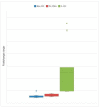Ionizing Radiation from Radiopharmaceuticals and the Human Gut Microbiota: An Ex Vivo Approach
- PMID: 36142722
- PMCID: PMC9506506
- DOI: 10.3390/ijms231810809
Ionizing Radiation from Radiopharmaceuticals and the Human Gut Microbiota: An Ex Vivo Approach
Abstract
This study aimed to determine the effect of three widely used radiopharmaceuticals with intestinal excretion on selected relevant bacteria that are part of the human gut microbiota, using an ex vivo approach. Fecal samples obtained from healthy volunteers were analyzed. Each sample was divided into four smaller aliquots. One served as the non-irradiated control. The other three were homogenized with three radiopharmaceutical solutions ([131I]NaI, [99mTc]NaTcO4, and [223Ra]RaCl2). Relative quantification of each taxa was determined by the 2-ΔΔC method, using the ribosomal gene 16S as an internal control (primers 534/385). Twelve fecal samples were analysed: three controls and nine irradiated. Our experiment showed fold changes in all analyzed taxa with all radiopharmaceuticals, but results were more significant with I-131, ranging from 1.87-83.58; whereas no relevant differences were found with Tc-99m and Ra-223, ranging from 0.98-1.58 and 0.83-1.97, respectively. This study corroborates limited existing research on how ionizing radiation changes the gut microbiota composition, providing novel data regarding the ex vivo effect of radiopharmaceuticals. Our findings justify the need for future larger scale projects.
Keywords: Radium-223; Technetium-99m; commensal microbiota; gut microbiota; ionizing radiation; radiation toxicity; radioiodine; radiopharmaceuticals.
Conflict of interest statement
The authors declare no conflict of interest.
Figures
References
-
- Desouky O., Ding N., Zhou G. Targeted and non-targeted effects of ionizing radiation. J. Radiat. Res. Appl. Sci. 2015;8:247–254. doi: 10.1016/j.jrras.2015.03.003. - DOI
MeSH terms
Substances
LinkOut - more resources
Full Text Sources



